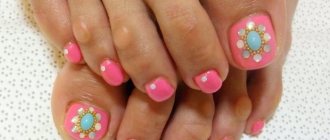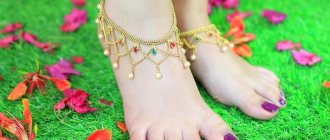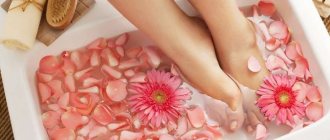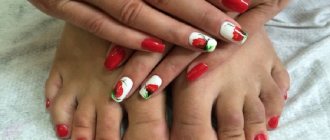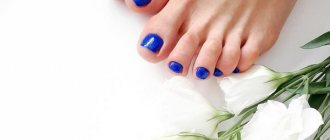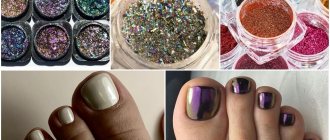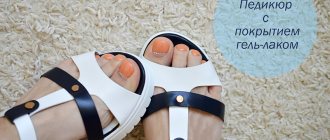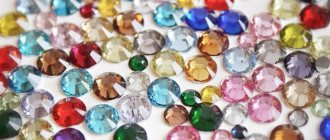You need to take care of your body not only for aesthetics, but also for health. A pedicure will preserve the beauty of your feet and help avoid various diseases. Now this is taught in courses, and pedicurists can be found in all beauty salons. If you still want to learn how to do it yourself, read our article.
In this article we will tell you:
- What is a pedicure?
- How long does a pedicure take?
- Types of pedicure Classic pedicure
- Dry pedicure
- Hardware pedicure
- European pedicure
- Medical pedicure
How much does a pedicure cost?
The price of a pedicure varies from 1,000 to 4,000 rubles depending on the type of service. In addition, the region in which you are located plays an important role. A pedicure will cost you the most in Moscow and St. Petersburg, and in other regions it is a couple of thousand rubles lower.
The most expensive is a medical pedicure, while the European one is cheaper.
If you want to learn how to do a pedicure yourself and not depend on a manicurist's schedule, sign up for a manicure and pedicure course.
During the courses you will be taught how to perform different types of pedicure, as well as how to massage your feet and how to use tools correctly. Classes are suitable for both beginners and those who want to improve their skills and acquire useful skills.
Please note that the courses include not only theory, but also practice. There you will practice your acquired knowledge on models.
On average, the course takes 5 lessons of 3-5 hours and costs from 7,000 to 20,000 rubles.
We hope that pedicure did not seem like a complicated procedure to you. Be patient and experiment. If you still weren’t able to learn on your own, be sure to sign up for a pedicure course and master all types of this procedure.
This training may be right for you:
- Best Online Manicure Courses from 1,000 Rubles
- 10 Best Manicure Training Courses in Moscow
- 10 Best Manicure and Pedicure Courses in St. Petersburg
- Best Nail Extension Courses in Moscow from 1,000 Rubles
- 10 Pedicure Training Courses in St. Petersburg
- 10 Best Nail Extension Courses in St. Petersburg
Choose the Best Courses in Your City: Yekaterinburg , Krasnodar , Nizhny Novgorod , Novosibirsk , Rostov-on-Don , Perm , Krasnoyarsk , Voronezh , Omsk .
Execution technology
Depending on the specific problem, the medical pedicurist performs a number of actions to help treat the disease or alleviate the client’s condition.
If the pathology cannot yet be completely cured, he will take measures to achieve long-term and sustainable remission.
General procedure for medical pedicure:
- Oral conversation with the client. Definition of the problem, identification of possible factors of its occurrence;
- Visual examination of the affected foot;
- Prescribing a treatment regimen and necessary manipulations;
- Carrying out a pedicure procedure using the instruments and products selected for treatment - keratolytics, blades, staples;
- Skin hydration and cuticle hydration.
Decorative coating of nails in medical pedicure, as a rule, is not carried out. Informing the client about the purpose and method of the treatment procedure is mandatory. This will allow him to calm down, relax, and not strain the muscles of his feet.
Ingrown nail

Before the advent and spread of medical pedicure, the problem of ingrown toenails was solved only in the surgeon's office. Now you can correct the situation without surgery.
Causes of ingrown nails:
- Improper cutting of nails during pedicure, poor quality treatment of the free edge of the nail on the big toe;
- Systematic heavy load on the feet, including due to excess weight;
- Wearing shoes that don't fit;
- Flat feet;
- Hallux valgus;
- Diseases associated with disruption of the functioning of internal organs, for example, diabetes;
- Skin diseases affecting the nail structure - fungus, psoriasis;
- Anatomical features.
Symptoms:
- Constant pain in the ingrowth area;
- Inflammation and purulent discharge;
- Deformation of the finger shape, pathological proliferation of soft tissues.
For treatment, a podiatrist:
- Performs a visual inspection of the foot, analyzes the degree of ingrowth and conducts a survey to determine the systematic nature of the problem. If the ingrown nail has already reached an advanced stage, the master sends the client to a surgeon for subsequent removal of the nail plate;
- Makes a cast of a nail from acrylic or plaster, completely repeating all its features;
- Makes a bracket. This requires 3-5 days;
- Places prepared wire material on the problematic nail.
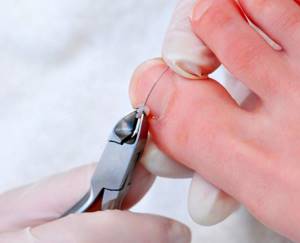
Lyudmila Sheveleva
Doctor, pharmacist
Ask a Question
Please note that sometimes a visual examination alone is not enough to make a diagnosis. An x-ray is also performed in two projections to identify signs of the spread of purulent inflammation. The study is indicated in severe cases, therefore it is prescribed to few patients. Treatment of an ingrown toenail is not limited to one visit to a specialist. Depending on the individual characteristics of the patient, the problem is solved from 1 month to 2 years.
After installing the brace, the patient must:
- Come for correction at least once every 2 months;
- Keep your feet clean by washing them several times a day with soapy water;
- Wear comfortable shoes that do not squeeze the problem toe.
In addition to staples, threads and plates are also used. The technology for working with them is practically the same and excludes only the creation of an impression.
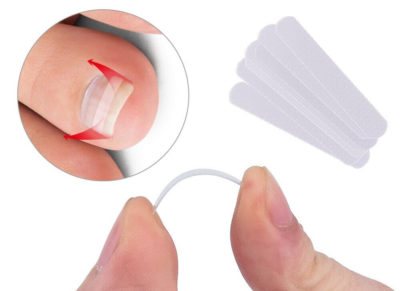
Core calluses
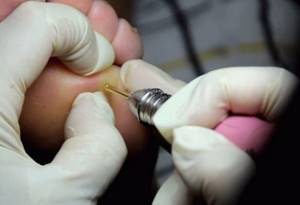
If you develop a compacted, painful callus, do not self-medicate - if it is a core, deep callus, you will not be able to deal with it with creams.
Causes of calluses:
- Constantly wrinkled shoe insoles, causing foot friction;
- Damage to the skin, for example, a splinter;
- Poor quality shoes that do not allow air to pass through;
- Too high heels or, conversely, flat soles;
- Fungus or viral infection;
- Entry of small foreign bodies into the skin of the foot;
- Frequent walking barefoot;
- Clubfoot, flat feet;
- Presence of dry calluses;
- Excess body weight.
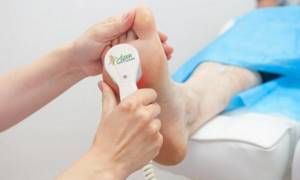
Several methods of removing callus are used:
- Cryodestruction . The most common method, tested repeatedly in the fight against calluses of varying severity. It involves burning with liquid nitrogen. Under the influence of ultra-low temperature, keratinized cells become necrotic. The procedure lasts less than one minute and has a low recurrence rate.
- Laser destruction . The laser removes the callus down to the very base. The main advantage of the method is that during the procedure all bacteria formed in the deep layers of the epidermis are removed. After laser removal, no inflammatory processes occur;
- Hardware removal . The technician drills out the callus using a special nozzle, carefully cleaning the resulting canal. After the procedure, a product with an antibacterial effect is placed into the vacated cavity. There are no complications after such removal. The risk of inflammation and relapse is almost zero. Complete reduction of the callus is carried out within 1-5 sessions.
Prevention:
- Choose shoes made of genuine leather or suede so that your feet always “breathe”;
- Change shoe insoles immediately after they become deformed - scuffs, bruises and tears;
- Do a pedicure systematically - treat the skin with pumice, scrubs or keratolytics;
- Don't wear other people's shoes.
Gehwol products for solving foot skin problems
Hyperkeratosis

Hyperkeratosis is a foot disease accompanied by an increase in the number of keratin cells and thickening of the stratum corneum. If you notice symptoms of hyperkeratosis, contact a specialist who will prescribe medication or hardware treatment.
Symptoms of hyperkeratosis:
- The appearance of coarsened, compacted areas;
- Peeling and dryness;
- Change in skin color in rough areas. Instead of pinkish, corns take on a white or yellowish tint;
- Pain and burning when walking;
- Feeling of stiff feet.
After contacting the podiatrist, the specialist:
- Conducts an examination to confirm the diagnosis and determine its neglect;
- Uses emollients - keratolytics, which destroy lipid bonds and facilitate the removal of the stratum corneum;
- Cuts off keratinization with a scalpel without damaging soft tissue;
- Grinds the skin with a milling cutter with a ceramic attachment.
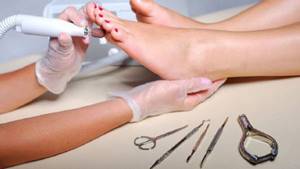
In addition to hardware removal of hyperkeratosis foci, more modern techniques are used as part of medical pedicure:
- Laser burning. The laser dries out the keratinization, leaving a small scar on the skin;
- Freezing of keratinized tissues with liquid nitrogen;
- Excision of corns with an electric knife;
Prevention of hyperkeratosis:
- Choose comfortable shoes made from quality materials;
- Use moisturizing creams;
- Carry out periodic removal of the stratum corneum with pumice, scrubs or keratolytics;
- Start treating skin diseases in a timely manner.
Please note that without prevention, hyperkeratosis will definitely return. It should be remembered that with age, the roughening of the skin on the feet becomes more and more pronounced.
Foot skin problems and what a pedicurist should do if they exist
Cracks
Skin cracks on the feet and heels are a violation of the integrity of the skin associated with deep tears. Minor cracks can be eliminated using moisturizing creams and healing ointments, but for more serious cracks, a systematic medical pedicure procedure will be required.
It is important to know that cracks are not an independent disease, but only a manifestation of a more serious pathogenic process developing in the body.
Common causes of ruptures are:
- Disorders of the thyroid gland;
- Diabetes;
- Psoriasis;
- Avitaminosis;
- Disturbed hormonal levels;
- Incorrectly selected shoes;
- Too active lifestyle.
The pedicure procedure consists of:
- Conversations between a specialist and a client, identifying possible causes of crack formation;
- Examination of the affected foot and analysis of the degree of neglect;
- Filing the skin around cracks to improve penetration of healing agents;
- Prescriptions of medicinal ointments and creams.
Cracks in the skin of the heels - treatment and prevention
Creams and preparations for cracked heels
Medical pedicure for the treatment of cracks will have to be repeated every two weeks. This will allow the podiatrist to promptly and professionally get rid of growths and monitor the overall change in condition.
Lyudmila Sheveleva
Doctor, pharmacist
Ask a Question
In addition, the podologist can send you to a dermatologist, who will prescribe the necessary tests to identify the real cause of the formation of cracks. But no matter what, you need to start treatment immediately. Moreover, the cracks cause pain while walking.
How to choose foot cream with urea
Nail deformation
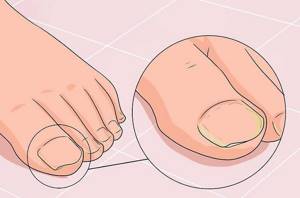
Nail deformation is a change in the structure and appearance of the nail plate, which causes not only external discomfort, but also pain.
In this case, it is impossible to solve the problem with creams and medicinal varnishes - you must contact a specialist.
Deformation of the nail plate is determined by visual examination and is confirmed if the nails:
- They have grooves, depressions, bulges;
- Cracks at the base;
- They have a blue tint;
- Globular, very convex;
- Curved, resembling the shape of a claw;
- Thickened or thinned;
Treatment of a deformed nail can be medicinal or surgical. In order to confirm the presence of deformation, contact a pedicurist with podological education.
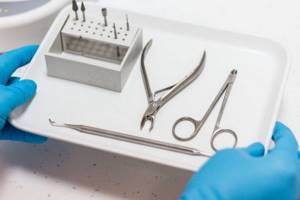
During the procedure, the specialist:
- Conduct a visual inspection of the nail and determine what type of deformation you are experiencing;
- Removes keratinization, cuticle and cleans side ridges. Polish the nail if there are no contraindications;
- He will prescribe treatment with ointments and creams or refer you for a consultation with a surgeon.
Nail deformation is most often a consequence of:
- Lack of vitamins and poor nutrition;
- Serious injuries to the nail bed;
- Congenital anomalies;
- Past dermatological diseases.
Lyudmila Sheveleva
Doctor, pharmacist
Ask a Question
You will be interested to know that nails become deformed due to frequent contact with: detergents and cleaners, fertilizers, solvents and other aggressive substances. Often their shape changes as a result of frequent extensions and the use of decorative coatings of dubious quality.
Onychomycosis
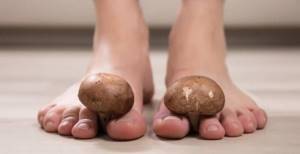
Onychomycosis is a fungal infection of the nail plate and adjacent skin.
To determine the disease, it is not enough to rely only on changes in the appearance of the nail, so a trip to a medical pedicure to a master podiatrist is simply necessary.
In clinics, scrapings are taken to confirm the diagnosis and examined using a microscope. Inoculation of the studied material on nutrient media is also practiced.
After the fungus is confirmed, a hardware medical pedicure is performed:
- Removal of the damaged area of the nail with a milling cutter by filing it down;
- Cleaning the remaining surface of the nail, as well as treating nails not affected by fungus;
- Application of antifungal drugs;
- Consultation on the prevention of recurrence of onychomycosis.
After a medical pedicure to treat fungus, it is not recommended to apply a decorative coating to ensure air access to the affected area.

Symptoms indicating the possible development of a fungal infection:
- Change in color of the nail plate - from reddish to gray;
- Partial destruction of the damaged area;
- Thickening in the affected area;
- Increased nail fragility and ability to crumble;
- Separation of the horny plate from the nail bed.
Prevention of the appearance and development of fungal infections;
- Don't wear someone else's shoes;
- Do not walk without shoes in public places - swimming pools, saunas;
- Do not wear low-quality shoes, as well as synthetic socks and tights;
- Contact a specialist promptly at the first manifestation of symptoms.
Green nails and pseudomonia disease: causes, diagnosis and treatment options
Contraindications
Before starting a pedicure, the cosmetologist examines the condition of the feet and nails in order to prescribe a course of treatment, and also makes sure that there are no contraindications for health reasons that could lead to side effects.

The limitations are due to the fact that during the session he uses a special device, the improper use of which can influence the state of the girl’s hormonal levels.
As a standard, few prohibitions are prescribed:
- Diabetes;
- Pregnancy and breastfeeding;
- The presence of an allergic reaction to the drugs or compositions used;
- Infectious lesions of the feet, dermatitis;
- The presence of benign neoplasms on the client’s legs;
- Reduced blood clotting, which can lead to the formation of a wound from which the flow of blood will be difficult to stop.
It is important to take into account the health restrictions that the master will prescribe in order to ensure a positive outcome of the manipulations and prevent their aggressive impact on the girl’s health.
